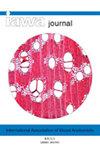潮间带浸水考古木材中细菌腐烂在细胞类型和细胞壁区域之间的变化
IF 3.5
3区 农林科学
Q2 FORESTRY
引用次数: 7
摘要
对800多年前埋在西海中部潮间带的“大岛2号沉船”中被水浸湿的考古木材(WAW,硬松木)的细菌腐烂现象进行了调查。外部部件的最大水分含量(约为。3 cm深度)的WAW比未降解的参考松材高约4.2倍。ATR-FTIR和固态13C-NMR分析表明,纤维素和半纤维素的降解导致WAW中的木质素浓度相对增加,整个研究板(31 cm宽,14.5 cm厚)。微观形态学研究还显示,细菌降解进展到距离表面15厘米(垂直7.3厘米)的深度,这是板的最内层。侵蚀菌(EB)是WAW的主要降解菌。偶尔发现隧道细菌(TB)的降解。WAW对细菌攻击的耐腐性因细胞类型和细胞壁区域而异。轴向管胞的阻力小于射线管胞、射线薄壁细胞和轴向管间细胞(包括链管胞、附属薄壁细胞和上皮细胞)。射线管胞和链管胞的耐腐性分别高于射线薄壁细胞和副薄壁/上皮细胞。有边界和交叉场的坑膜和初始坑边界比管胞细胞壁具有更高的抗腐性。总体而言,轴向管胞的S2层对细菌攻击的抵抗力最弱。本文章由计算机程序翻译,如有差异,请以英文原文为准。
Variations in bacterial decay between cell types and between cell wall regions in waterlogged archaeological wood excavated in the intertidal zone
The bacterial decay of waterlogged archeological wood (WAW, hard pine spp.) taken from Daebudo shipwreck No. 2, which was buried in the intertidal zone in the mid-west coast (Yellow sea) of South Korea approximately 800 years ago, was investigated. The maximum moisture content of the outer parts (approx. 3 cm of depth) of WAW was approximately 4.2 times higher than that of undegraded reference pine wood. ATR-FTIR and solid-state 13C-NMR analysis indicated a relative increase of the lignin concentration in WAW caused by the degradation of cellulose and hemicelluloses across the board studied (31-cm-wide and 14.5-cm-thick board). Micromorphological studies also revealed that bacterial degradation was progressed to a depth of 15 cm (vertically 7.3 cm) from the surface, which is the innermost part of the board. Erosion bacteria (EB) were identified as the main degraders of WAW. Degradation by tunneling bacteria (TB) was occasionally detected. Decay resistance to bacterial attacks in WAW varied between cell types and between cell wall regions. Axial tracheids showed less resistance than ray tracheids, ray parenchyma cells, and axial intercellular canal cells, including strand tracheids, subsidiary parenchyma cells, and epithelial cells. Decay resistance was higher in ray tracheids and strand tracheids than in ray parenchyma cells and subsidiary parenchyma-/epithelial cells, respectively. Bordered- and cross-field pit membranes and the initial pit borders showed higher decay resistance than the tracheid cell walls. Overall, the S2 layer of the axial tracheids showed the weakest resistance to bacterial attacks.
求助全文
通过发布文献求助,成功后即可免费获取论文全文。
去求助
来源期刊

IAWA Journal
农林科学-林学
CiteScore
3.40
自引率
15.80%
发文量
26
审稿时长
>36 weeks
期刊介绍:
The IAWA Journal is the only international periodical fully devoted to structure, function, identification and utilisation of wood and bark in trees, shrubs, lianas, palms, bamboo and herbs. Many papers are of a multidisciplinary nature, linking
 求助内容:
求助内容: 应助结果提醒方式:
应助结果提醒方式:


